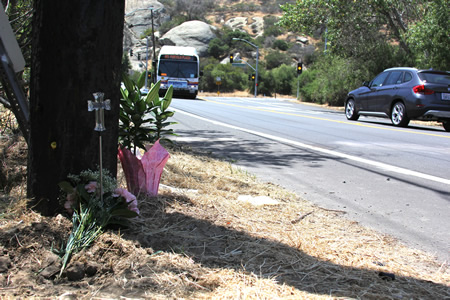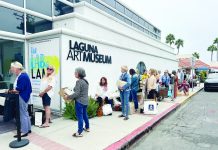
By Breeana Greenberg, Special to the Independent
Laguna Beach City Council voted Tuesday to revise and resubmit a study to improve Laguna Canyon Road, potentially with a reversible transit lane to relieve traffic congestion.
“We’ve spent so much time and effort as a community looking at Laguna Canyon Road, I think we all get the continual Nixles about the disasters that are happening out there,” Mayor Bob Whalen said. “Doing nothing is not an option in my view, we have to move forward with looking at some of these alternatives.”
The study, first submitted to Caltrans in November 2019, looked to underground overhead utilities and create bike and pedestrian lanes. In April 2019, the City Council directed staff to further study transit improvements like reversible transit lanes and longer merge lanes.
To improve traffic flow, councilmembers directed staff to look at turning the center, left-turn lane into a reversible transit lane. The reversible transit lane would alternate the direction of travel depending on traffic. Drivers would only be able to enter or exit the lane from street lights. Mark McAvoy, director of public works, also discussed using the lane as a HOV or toll lane.
“I think the reversible lane idea is great,” resident Judie Mancuso said. “I think that it would just be stupendous if locals with our tags were able to get in that lane and possibly share with the HOV and that way, locals don’t have to be as inconvenienced by the millions and millions of tourists coming through.”
“We will have a much better chance of winning federal funding through OCTA if we had a HOV or transit reversible lane as part of our project,” City Manager Shohreh Dupuis said. “And also the Caltrans director indicated that our bicycle and pedestrian improvements are a key component of our project, then we would have access to state funding…”
The cost of implementing the reservable transit lanes is yet to be determined as transit improvements still need to be studied more. In their vote, councilmembers approved a contract amendment with HDR Engineering, Inc. for up to $200,000 to revise the study report as well as a contract amendment with Caltrans for a maximum of $25,000 to review the revised study.
McAvoy outlined the plan to possibly widen the shoulders on Laguna Canyon Road and add a sidewalk and bikeway. The report offered two options for a bike lane. If City Council decides to create a reversible transit lane in the center lane, then staff would look to build a class two or “on-road” bike lane. If City Council decides against the reversible transit lane then staff would look to build a two-way bike lane separated by a curb from the main road on the southbound side Laguna Canyon Road.
Resident Ann Christoph objected to the proposed road widening.
“[Village Laguna] objected to a wider road because of the aesthetic impacts of an expanse of pavement and this option does that all by itself,” Christoph said. “And it provides a bike lane that is inaccessible from the community side of the street. So it would be like a bike freeway for people that come from far away, presumably.”
Councilmember George Weiss agreed that the bike lane would end up largely serving cyclists coming from out of town.
“I don’t see it as a neighborhood, residents-serving bike lanes so that’s a problem for me and keeping it small would be…one solution, I suppose,” Weiss said.
“I think one of the visions we had back on the taskforce, both for the pedestrian and bike lanes, was to connect the downtown,” Whalen said. “We could connect our community out to the open space. You can’t get out there safely now, either walking or riding a bike, but with these improvements you could.”
The cost to construct the pedestrian and bike lanes is estimated to be $43.5 million. The construction would also require that overhead utilities be undergrounded.
Undergrounding utilities reduces fire risk, improves traffic safety and preserves the Laguna Canyon Road evacuation route, and increases the reliability of utility service, the staff report explains. The cost to underground the canyon lines is estimated to be about $71 million.
“I think that realistically, this is only going to happen with state and federal money for the most part,” Whalen said. “I mean, we will be able to contribute some locally but I think, my personal view is we need to invest the extra $100,000 here.”
City Council voted to appropriate $100,000 from the Wildfire Mitigation and Fire Safety Fund for the utility undergrounding project. Council also directed staff to get a cost proposal from Southern California Edison for the undergrounding of transmission lines along Laguna Canyon Road from Canyon Acres to El Toro Road.
Currently, Laguna Canyon Road is owned by Caltrans. The California legislature passed Assembly Bill 2172,in September 2020, allowing Laguna Beach to acquire the Laguna Canyon Road from Caltrans. Prior to the passage of the assembly bill, The City entered into a contract with HDR Engineering, Inc to look at a cost benefit analysis of acquiring Laguna Canyon Road.
“Acquiring Laguna Canyon Road on its own, in its present state, really doesn’t provide a substantial benefit; however if we implemented these various improvement projects as detailed, then that would result in benefits that outweigh the costs,” McAvoy said.
Maintaining Laguna Canyon Road would cost the City an estimated $193,000 a year and another $193,000 for emergency road closures. Crash related legal claims and settlements could also cost the city up to $11 million per year.
As part of its vote, City Council directed staff to enter negotiations with Caltrans for the acquisition of Laguna Canyon Road if the city is able to identify funding for the bike, pedestrian, transit, and utility undergrounding improvements.
“The City having control of Laguna Canyon Road could be a very good thing and I know that a huge amount of work has gone into this already,” said Penelope Miline, president of the Canyon Alliance of Neighborhoods Defense Organization.
“While I’ve strongly advocated for underground in the power lines in the canyon, I am concerned about the proposal to underground them in the Wilderness Park,” Milne said.
Milne pointed out that a potential downside to undergrounding power lines is the disruption of wildlife habitats and recommended that City Council direct staff to work with Southern California Edison to look at a variety of alternatives, not just undergrounding utilities in the Wilderness Park.
Milne also noted that the reversible transit lane may make it more difficult for residents to get in and out of their neighborhoods.
“I think you all know how much the town hates the signal at LCAD, so the idea that we would solve the people’s frustration by adding three or four more lights would be extremely unpopular,” Milne said.





HDR Engineering designs car-centric traffic solutions to move more cars faster, they use Caltrans Level of Service (LOS) criteria for success – right out of 1950 San Fernando Valley. So now the city of Laguna Beach will task HDR with a car-centric solution for LCR at $200,000! Are you nuts?
OCTA/Caltrans has already provided a PCH corridor study for Newport, Laguna Beach, Dana Point and San Clemente with recommendations for a multi-modal system – exactly what Laguna needs. Their recommendations for Laguna Beach begin on page 14 of the Executive Summary, they give solutions for Glenneyre too.
The OCTA/Caltrans PCH Corridor is consistent with the Caltrans mandate in Deputy Directive 64 Complete Streets Policy. The OCTA/Caltrans Corridor solution is consistent with the OCTA Get Moving initiative for our coastal cities.
WHY DOES OUR CITY LEADERSHIP DENY LAGUNA RESIDENTS SOLUTIONS TO TRAFFIC CONGESTION?
Our city leadership would rather fall-over dead than say the words: COMPLETE STREETS POLICY.
RE “Maintaining Laguna Canyon Road would cost the City an estimated $193,000 a year and another $193,000 for emergency road closures. Crash related legal claims and settlements could also cost the city up to $11 million per year”
Sounds like a fiscally nutty idea to buy this money losing venture. Why would we want to PAY to take this over? Seems like it should be the other way around, that the City gets paid to take over the road plus an apportionment of gas taxes and tolls to fund the maintenance.
I’m with Mr. Tang on this and I have additional concerns regarding liabilities, indemnification rates, etc.
Settlements “could cost up to $11 million per year.”
Hmmmm. How can someone project an actual ceiling on litigation?
Let’s say that the City follows Les’ most excellent criteria, actually State mandated guidelines.
Will we have not only increased bicycle traffic but possible pedestrians due to aprons/lanes?
Seems so.
And will these “improvements” entice long distance runners?
What about those increasingly pesky electric bikes, usually a younger less urban/commuter road savvy crowd?
In other words, how much indemnification will we actually need?
It’s a pig in a poke.
Too risky, unlike DOT (CalTrans) with a humungous deep pocket, how deep is ours?
It’s California, known for litigious confrontations.
I guarantee some personal injury/wrongful death attorney will tell us how much severely injured person or death is worth.
And WE may not be the ones benefitting, could be visitors.